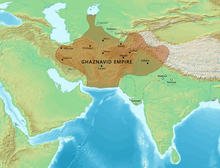Ghaznavids
Appearance

The Ghaznavid dynasty (Persian: غزنویان ġaznaviyān) was a Persianate Muslim dynasty of Turkic mamluk origin, ruling, at its greatest extent, large parts of Iran, Afghanistan, much of Transoxiana and the northwest Indian subcontinent from 977 to 1186. The dynasty was founded by Sabuktigin upon his succession to the rule of Ghazna after the death of his father-in-law, Alp Tigin, who was an ex-general of the Samanid Empire from Balkh, north of the Hindu Kush in Greater Khorasan.
Quotes
[edit]- “In the year AH 427 (AD 1036)… he himself marched with an army to India, to reduce the fort of Hansy… Herein he found immense treasure, and having put the fort under the charge of a trusty officer, he marched towards the fort of Sonput. Depal Hurry, the governor of Sonput, abandoned the place, and fled into the woods; but having no time to carry off his treasure, it fell into the conqueror’s hands. Musaood having ordered all the temples to be razed to the ground, and the idols to be broken proceeded in pursuit of Depal Hurry…”
- About Sultãn Mas‘ûd I of Ghazni (1030~1042) Sonipat (Haryana) Tãrîkh-i-Firishta, translated by John Briggs under the title History of the Rise of the Mahomedan Power in India, first published in 1829, New Delhi Reprint 1981, Vol. I, p. 63.
- “In his reign Hajib Toghantugeen, an officer of his government, proceeded in command of an army towards Hindoostan, and being appointed governor of Lahore, crossed the Ganges, and carried his conquests farther than any Mussulman had hitherto done, except the Emperor Mahmood. Like him he plundered many rich cities and temples of their wealth, and returned in triumph to Lahore, which now became in some measure the capital of the empire, for the Suljooks having deprived the house of Ghizny of most of its territory both in Eeran and Tooran, the royal family went to reside in India.”
- About Sultãn Mas‘ûd III of Ghazni (AD 1099-1151) Uttar Pradesh Tãrîkh-i-Firishta, translated by John Briggs under the title History of the Rise of the Mahomedan Power in India, first published in 1829, New Delhi Reprint 1981, Vol. I, p. 82
- “…He marched with his army to the fort of Sonipat, and the commandant of that fort, Daniãl Har by name, becoming aware of his approach, fled… the army of Islam, having captured that fort, pulled down all the temples and obtained an enormous quantity of booty.”
- Tabqãt-i-Akharî by Nizamuddin Ahmad. About Sultãn ‘Abû-Sa‘îd Mas‘ûd of Ghazni (AD 1030-1042) Sonipat (Haryana) The Tabqãt-i-Akbarî translated by B. De, Calcutta, 1973, Vol. I, p. 22

